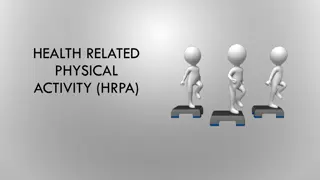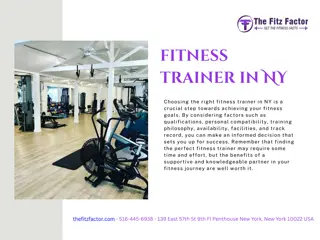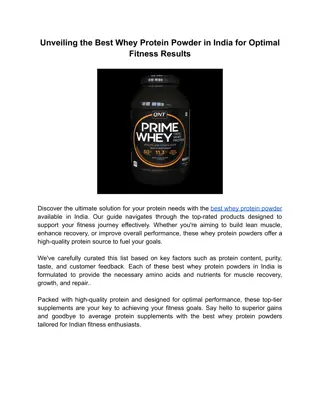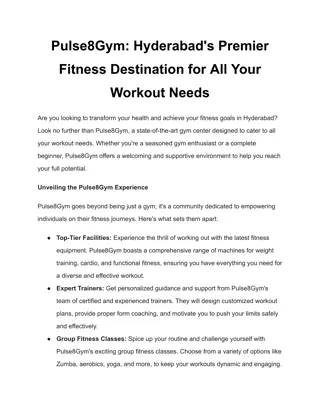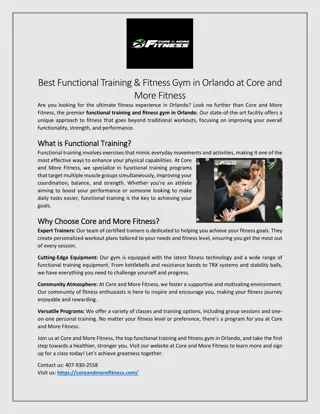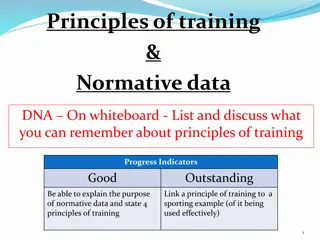
Essential Components of Physical Fitness and Their Importance
Understand the concept of fitness, the types of fitness, and the components that contribute to overall physical well-being. Explore health-related and skill-related fitness aspects, from strength and power to agility and flexibility. Learn how physical fitness enhances daily tasks, sports participation, and overall quality of life.
Download Presentation

Please find below an Image/Link to download the presentation.
The content on the website is provided AS IS for your information and personal use only. It may not be sold, licensed, or shared on other websites without obtaining consent from the author. If you encounter any issues during the download, it is possible that the publisher has removed the file from their server.
You are allowed to download the files provided on this website for personal or commercial use, subject to the condition that they are used lawfully. All files are the property of their respective owners.
The content on the website is provided AS IS for your information and personal use only. It may not be sold, licensed, or shared on other websites without obtaining consent from the author.
E N D
Presentation Transcript
CONCEPT OF CONCEPT OF FITNESS FITNESS
FITNESS FITNESS The ability to perform daily task vigorously and alertly, with energy left over for enjoying leisure time activity and emergency demands. It is the ability to endure, to bear up, to withstand stress, to carry on in circumstances where unfit person could not continue, and is a major basic for good health and well-being. Participating in physical activity is beneficial to people of all ages. Physical activity contributes to fitness, a state in which people s health characteristics and behaviors enhance the quality of their lives. A set of physical attributes related to a person s ability to perform physical activity successfully, without undue strain and with a margin of safety.
TYPES OF FITNESS TYPES OF FITNESS 1. Health-related physical fitness A physiological state of well-being that reduces the risk of hypokinetic disease; a basis for participation in sports; and a vigor for the tasks of daily living. Components include cardio-respiratory endurance, muscle strength endurance, flexibility, and body composition.
2. Skill-related physical fitness Common components of physical fitness (e.g., agility, balance, coordination, speed, power, reaction time) that enable participation in sports and other physical activities; also called performance or motor fitness.
COMPONENT OF FITNESS COMPONENT OF FITNESS 1. Strength: The extent to which muscles can exert force by contracting against resistance. 2. Power: The ability to exert maximum muscular contraction intensely in an explosive burst of movement. e.g. jumping, sprinting start 3. Speed: The quick movement of limbs, whether leg of sprinter or arms of shot putter. 4. Agility: The ability to perform a series of explosive power movements in rapid succession in opposing directions.
5. Balance: The ability to control the bodys position either in stationary or moving position. 6. Flexibility: The ability to achieve an extended range of motion without being impeded by excess tissues. 7. Muscular Endurance: A single muscle ability to perform sustained work, e.g. rowing, cycling. 8. Cardiovascular Endurance: The heart s ability to deliver blood to working muscles and their ability to use it, e.g. long distance running. 9. Strength Endurance: A muscle s ability to perform a maximum contraction against resistance. 10. Co-ordination: The ability to perform effectively with other components.
BENEFITS/scope OF FITNESS BENEFITS/scope OF FITNESS Improves health: Increase efficiency of heart and lungs. Reduce cholesterol level. Increase muscular strength. Reduce blood pressure. Weight loss. Improves Appearance: Toned muscles. Improves posture.
Improves Sense of Well-Being More energy. Less stress Improve quality of sleep Improves ability to cope with stress Increase mental sharpness. Increase Stamina Increase productivity Increase physical capabilities Less injuries Improve immunity to major illness
Wellness Wellness
Wellness is optimal health and vitality. The constant and deliberate effort to stay healthy and achieve the highest potential for well-being. Living a lifestyle that optimizes all aspects of health. Wellness is the product of healthy lifestyles just like fitness is the product of regular exercise. Wellness reflects how one feels about life as well as one s ability to function effectively.
Dimensions of wellness Dimensions of wellness Physical wellness Emotional wellness Intellectual wellness Spiritual wellness Interpersonal and social wellness Environmental, or planetary, wellness
Reaching Wellness Through Reaching Wellness Through Lifestyle Management Lifestyle Management Getting started: Examine your current health habits Choose a target behavior an isolated behavior selected as the object for a behavior change program Obtain information about your target behavior Find outside help if needed
Benefits of a Wellness Benefits of a Wellness Lifestyle Lifestyle To the Nation Reduction in health care costs Maintenance of productive work force To the individual Reduced health care costs Increased longevity Increased quality of life



